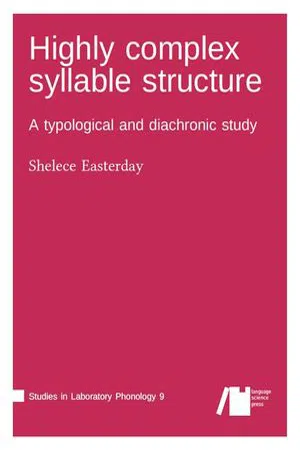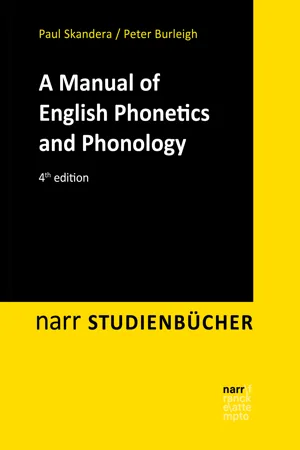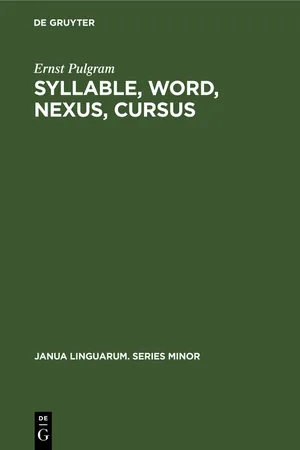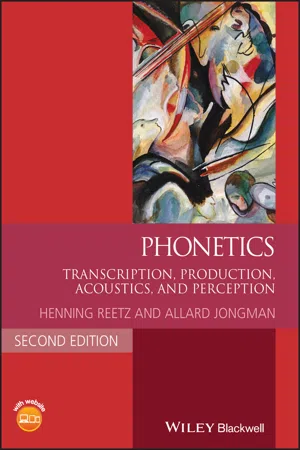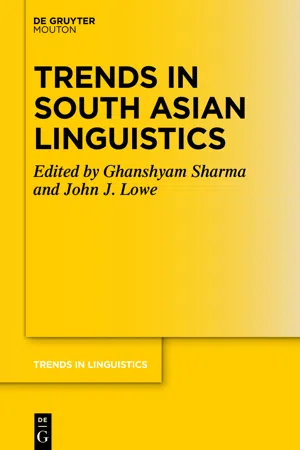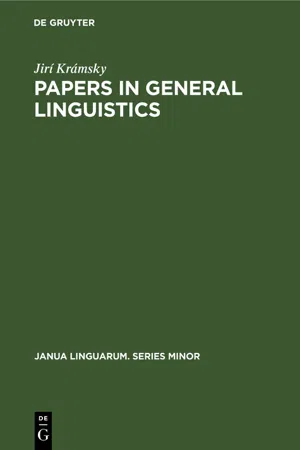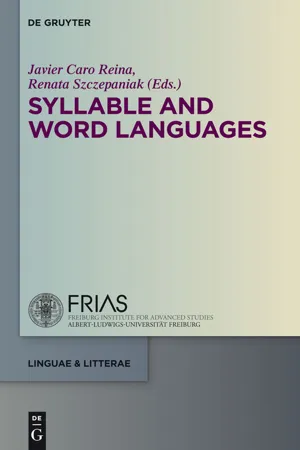Languages & Linguistics
Syllable
A syllable is a unit of sound in spoken language, typically containing a vowel sound and possibly one or more consonants. It is a fundamental building block of words and is important in understanding the rhythm and structure of language. Syllables are often used in linguistic analysis to study phonology and phonetics.
Written by Perlego with AI-assistance
Related key terms
1 of 5
11 Key excerpts on "Syllable"
- Shelece Easterday(Author)
- 2019(Publication Date)
- Language Science Press(Publisher)
1 Syllables and Syllable structure A Syllable is typically thought of as a unit which speakers use to organize se-quences of sounds in their languages. The division of the speech stream into Syllables refects the higher levels o f organization which are used in the cogni-tive processes by which speech is planned and perceived. Syllables are a common unit of abstract linguistic analysis; however, this unit seems to be more concrete and accessible to speakers than other phonological units such as segments. A speaker’s intuition of what is a pronounceable sequence of sounds is strongly infuenced by the Syllable patterns o f the language they speak. Most languages have relatively simple Syllable patterns, in which the alternation between rel-atively closed (consonantal) and relatively open (vocalic) articulations is fairly regular: Syllable patterns such as those in the English words pillow , cactus , and tree are crosslinguistically prevalent. Compare these patterns to the examples below (1–5): (1) Yakima Sahaptin ( Sahaptian ; USA) ksksa ‘elephant ear (mushroom)’ (Hargus & Beavert 2006: 29) (2) Georgian ( Kartvelian ; Georgia) bɾt͡s’χ’ali ‘claw’ (Butskhrikidze 2002: 204) (3) Tashlhiyt ( Afro-Asiatic ; Morocco) tsːkʃfstː t-sː-kʃf-t=stː ‘you dried it (f)’ (Ridouane 2008: 332) (4) Tehuelche ( Chonan ; Argentina) kt͡ʃaʔʃpʃkn k-t͡ʃaʔʃp-ʃ-k’n refl-wash-p s-realis ‘it is being washed’ (Fernández Garay & Hernández 2006: 13) 1 Syllables and Syllable structure (5) Itelmen ( Chukotko-Kamchatkan ; Russia) kɬtxuniŋeʔn kɬ-txuni-ŋeʔn ‘very dark’ (Georg & Volodin 1999: 55) To speakers of most languages, the long strings of consonants in these ex-amples are not pronounceable without a great deal of practice, being so di fer-ent from the relatively simpler patterns that are crosslinguistically prevalent. Yet such patterns are fuently acquired and maintained by native speakers o f these languages, and may even be relatively frequent in those languages.- eBook - PDF
- Lynne Cahill(Author)
- 2019(Publication Date)
- Bloomsbury Academic(Publisher)
What I love about Syllables is that everyone who speaks a language has an idea of what a Syllable is, and is usually able to identify how many Syllables there are in a word, but when you try asking them anything detailed about Syllables, they suddenly realise that they don’t really know very much about them at all, or what they thought they knew turns out to be wrong. This is where you can show off to your friends with your superior linguistic knowledge (well, assuming that you have the kind of friends who are impressed by this sort of thing)! The Oxford English Dictionary defines a Syllable as ‘a vocal sound or set of sounds uttered with a single effort of articulation and forming a word or an element of a word; each of the elements of spoken language comprising a sound of greater sonority (vowel or vowel equivalent) with or without one or more sounds of less sonority (consonants or consonant equivalents).’ There are two different kinds of definitions here, separated by the semicolon. The first one offers different options at two points. It is a vocal sound or set of sounds – so it is a set which may consist of a single sound. It forms a word or an element of a word – so a word might consist of one or more Syllables. All of this is fine, but it doesn’t say anything about how to spot whether a word has one or more Syllables, nor how many sounds might be combined into any particular Syllable. The next part of the definition helps a bit more and gets into the more technical side. A Syllable is an element of language that comprises a sound of greater sonority possibly combined with some sounds of less sonority. This is starting to look like something more helpful. It dif-ferentiates between vowels and consonants, but crucially it also allows for vowel-like and consonant-like sounds. As you’ll soon see, it is important not to be fooled into thinking that vowels and consonants can be easily divided into two clearly distinct, mutually exclusive groups of sounds. - eBook - PDF
A Manual of English Phonetics and Phonology
Twelve Lessons with an Integrated Course in Phonetic Transcription
- Paul Skandera, Peter Burleigh(Authors)
- 2022(Publication Date)
- Narr Francke Attempto Verlag(Publisher)
Lesson Seven: The Syllable One notion that we have used freely in previous lessons without giving any explanation is the notion of the Syllable [from Latin syllaba, Greek sullabē ´ , ‘taken, brought, or put together’; Silbe]. The reason why we have been able to do so is that most people have an intuitive sense of what a Syllable is, and they can probably define a Syllable vaguely as the smallest rhythmic unit of spoken language, for example, or a unit that is typically larger than a single sound and smaller than a word. Even without being able to give an exact definition, most people feel they can count Syllables, and say how many Syllables there are in a given word or sequence of words. On the other hand, studies have shown that, when English speakers are asked to count the Syllables of a concrete utterance, there is bound to be considerable disagreement among them. It becomes clear, then, that the notion of the Syllable is more elusive than is widely thought. In this lesson, we shall therefore discuss the Syllable in some detail. A phonetic approach to the Syllable You learnt in Lesson Three that consonants and vowels can be described both from a pho- netic point of view, i.e. in terms of how they are produced, and from a phonological point of view, i.e. in terms of where they occur. The same is true of the Syllable. Phonetically, a Syllable can be described as having a centre, also called peak or nucleus [Silbenkern, Sil- bengipfel, Nukleus], which is produced with little or no obstruction of air, and is therefore usually formed by a vowel (either a monophthong or a diphthong). The minimal Syllable, then, is typically a single, isolated vowel, as in the words are /ɑː/, err /ɜː/, and I /aɪ/. The few consonants that can occur in isolation, such as the interjections mm /m/ (used to express agreement) and sh /ʃ/ (used to ask for silence), are not regarded as minimal Syllables by all linguists. - eBook - PDF
- Ernst Pulgram(Author)
- 2019(Publication Date)
- De Gruyter Mouton(Publisher)
Indeed their shapes are predictable since they rest entirely upon phonotactic criteria, which are in turn derivable, as will be seen presently, from an analysis of the language into genuinely functional contrastive units. That is to say, once the analyst has found out what the phonemes, morphemes, and lexemes are, and how the representatives of each type are arranged into higher units, and once he has derived from this analysis phonotactic rules on what phonemes stand next to one another in what units, he actually possesses already the basic knowledge of how to syllabize an utter-ance, even though some indispensable refinements will have to be added — as will be demonstrated in Chapter 3A. I am therefore suggesting that the term 'Syllable' is not to be used in either a phonetic or a phonemic sense, but rather that it names a linguistic unit composed of phonemes that are arranged according to certain phonotactic criteria. A Syllable is, in other words, a phonological unit that is, as all linguistic units must be, describable and definable on its own level of analysis exclusively. 22 In the discussion of my paper read at the Phonetics Congress of 1964, THE Syllable AS A LINGUISTIC UNIT 23 If the Syllable is an operative unit of all languages, it is also a universal of language. Its definition must be, like that of the phoneme, the morpheme, and other linguistic units, the same for all languages, regardless of the varying unit inventories in the different idioms. But since the definition of the Syllable in any language is in fact a statement about syllabic boundaries exclusively, and since this statement must be a phonotactic rule on the consonants that may occur in the same Syllable as does the vowel nucleus, there arises the interesting question whether it might not be possible to arrive at a phonotactic definition of the Syllable which, unlike the formerly attempted but generally aborted phonetic definitions of it, does have universal validity for all languages. - eBook - ePub
Patterns of Spoken English
An Introduction to English Phonetics
- Gerald Knowles(Author)
- 2014(Publication Date)
- Routledge(Publisher)
CHAPTER 4The SyllableIn previous chapters we have examined sounds one at a time. We shall now turn to the groups and combinations into which sounds enter in connected speech. The smallest such group is the Syllable. Since the concept of the Syllable is a familiar and everyday one, it might be expected that linguists had long since agreed what the Syllable is, and how and why sounds group themselves into Syllables. In fact this is not so. The Swiss linguist de Saussure in his Course in General Linguistics , which was first published in French in 1916, suggested that the Syllable was based on the opening and closing of the vocal tract as the speaker moved from one sound to the next. This idea has an elegant simplicity which must be substantially correct. But as de Saussure himself pointed out, this basic idea does not account for all the patterns we might regard as Syllables. We shall therefore start with the basic Syllable and deal with the complications later.4.1 The principle of the SyllableThe chief criterion which governs the division of a string of phonemes into Syllables is the size of the oral cavity required for the different sounds. The SYLLABIC is the most open sound, generally a vowel. You can as a rule count the number of Syllables in a word or phrase by counting the number of vowel phonemes. The segment at the Syllable boundary is the closest sound. Any sounds between the boundary segment and the syllabic are arranged in order of increasing cavity size, and if any sounds follow the syllabic they are in decreasing order of cavity size.There are no generally agreed symbols for marking the parts of a Syllable, and what conventions there are arbitrary, untidy and unsystematic. A vertical dash is used in British works to mark the syllabic when it happens to be a consonant, e.g. button /bʌtņ/. But since in the opening sequence each segment has an aperture LESS THAN the next, we1 could use the symbol ‘<’ between each pair of segments, and similarly in the closing sequence, where each segment is GREATER THAN the next, we could use the symbol ‘>’. These symbols enable us to indicate the opening and closing of the Syllable, e.g. drunk - eBook - PDF
Phonetics
Transcription, Production, Acoustics, and Perception
- Henning Reetz, Allard Jongman(Authors)
- 2020(Publication Date)
- Wiley-Blackwell(Publisher)
Before any introduction of suprasegmentals, we need to discuss the notion of the Syllable since suprasegmental features such as stress and tone make reference to it. While most people have an intuitive notion of what a Syllable is, it is quite difficult to define a Syllable using phonetic criteria. Syllables and suprasegmentals in a nutshell A Syllable consists maximally of an onset , a nucleus , and a coda , where nucleus and coda together form the rime . The nucleus is usually made up of vowels, sometimes of sonorant sounds, and onset and coda are made up of one or Syllables and Suprasegmentals Syllables and Suprasegmentals 235 more consonants, or they can be omitted. For example, I , my , isle, height, spliced [ ɑɪ , m ɑɪ , ɑɪ l, h ɑɪ t, spl ɑɪ st] are all one‐Syllable words with the pattern VV, CVV, VVC, CVVC, CCCVVCC, respectively. Although most people have an intuition about what a Syllable is, there is no unique acoustic way to define it. Typically, the sonority , that is, the relative loudness of a sound, increases from the onset of a Syllable towards the nucleus and decreases towards the coda. Sounds form a sonority hierarchy , with vowels having the highest sonority, followed by approximants, nasals, fricatives, and plosives, which have the lowest sonority. Single Syllables can carry the primary stress or secondary stress of a word, or they can be unstressed. Stress usually is accompanied by increased activity of the laryngeal muscles, an increase in subglottal air pressure, lengthening of vowels, an adjustment of formant frequencies, a change in spectral tilt, or a combination of these factors. There is no simple acoustic measurement of stress, although, again, listeners often have an intuition about which Syllable is stressed in a word or a phrase. - eBook - ePub
- Ghanshyam Sharma, John J. Lowe, Ghanshyam Sharma, John J. Lowe(Authors)
- 2021(Publication Date)
- De Gruyter Mouton(Publisher)
Vennemann 1968 ).In addition to the linguistic evidence, there has been considerable evidence for Syllables from psycholinguistic studies. These studies can be divided broadly between speech error analysis, chronometric data, frequency studies and language games. We will focus on speech errors and chronometric experiments as they are the major informants of the primary speech production models. Speech errors often – but not always – involve the movement or exchange of phonemes or phoneme sequences. Shattuck-Hufnagel (1983) , Laubstein (1987) , and Davis (1988) provide evidence from English speech errors to support the view of syllabic constituents. Davis (1988) in particular shows transpositions where Syllable-initial segments, vowels and Syllable-final segments exchange with their counterparts but it is extremely rare for Syllable onsets and codas to exchange positions between each other (MacKay 1972 ; Motley 1973 ; Nootboom 1969; Shattuck-Hufnagel 1979 ). It is also interesting to note that segment sequences that cross Syllable boundaries do not move together (Shattuck-Hufnagel 1983 ). Laubstein (1987) demonstrates, based on her investigations into naturally occurring speech errors, that while there was evidence for onset, peak and coda divisions, there was no evidence for the rhyme. Therefore, evidence for the internal structure of Syllables is mostly derived from linguistic evidence. Meyer (1992) - eBook - PDF
- Jirí Krámsky(Author)
- 2019(Publication Date)
- De Gruyter Mouton(Publisher)
This different looseness or closeness of the connection of two phonemes is evidently dependent on the degree FUNCTIONAL CONCEPTION OF THE Syllable 63 of sonority of both phonemes: the connection is closer when its first member is less sonorous than the other, and looser when the first member of the connection is more sonorous. Our second remark concerns the functional value of the Syllable. E. Polivanov 5 was the first to draw attention to the phonemic Syllable, which he called SYLLABEME , as the basic structural cell in speech strings. Similarly R. Jakobson 6 defines the Syllable as the elementary pattern underlying any grouping of phonemes. Ac-cording to Jakobson the basic principle of Syllable structure is a contrast of successive features within the Syllable. One part of the Syllable dominates over the other parts, especially in the Syllables containing the contrast vowel : consonant. Jakobson distinguishes CREST PHONEMES and SLOPE PHONEMES . Crest is usually formed by vowels, whereas slopes contain other phonemes. The difference between mono- and dissyllabic articulation of the word krvi, which we have explained as caused by different tension, Jakobson sees in the fact that when a more sonorous phoneme is in a less sonorous environment, its sonority is substantially reduced so that the unity of the Syllable may be preserved. In our opinion it is necessary to fuse both explanations into one: the regulation of sonority is sure to cooperate with the regulation of muscular tension. Let us try to find out the function of the Syllable in relation to the meaning of the word unit. We can hardly have a good idea of a coherent speech flow without syllabic division or articulation. - Ulrike Gut(Author)
- 2014(Publication Date)
For example, the relative vowel length and the duration of consonants (e.g. Ramus et al. 1999) or the relative duration of stressed and unstressed Syllables is compared (Bolinger 1981, Gut 2003). 3.3 The phonologieal word in English All speakers of English agree that English utterances consist of words strung together. It is, however, quite controversial what a word actually iso In writing, a word is defined as the letters between two blanks - the sentence "What is a word?" thus consists of four orthographie words. Yet, even in writing, there are some difficult cases such as body-paint, flower pot, What's and l've. Should these cases be considered one or two words? In speaking, the problem is even greater. There are no pauses between words in an utterance, all phonemes are strung together. How can the boundaries of individual words be determined? In fact, this is a major challenge for language learners who initially find it impossible to segment the speech stream into words. Phonologists have praposed the unit of the phonologieal word (pword). This is based on the reasoning that this is a unit in which various phonological pracesses apply. In particular, word stress (see section 3.3.1 below) happens within the string of speech sounds defined as the phonological word. Other processes that occur within the unit of pwords such as aspiration and velarization are described below in section 3.3.2. Consider structures like What's and l've again. The Isl and the lvi in each example cannot stand on their own phonologically. They do not fonn a pennissible Syllable but are incorporated into the Syllable structure of the English phonology: phonemes, syliables and words 89 preceding lwotl and lall, respectively. These structures that are dependent on phonologically adjacent words are called clitics. Ifthe word they are attached to, the host, precedes the clitic, they are called enclitics; if the clitic precedes the host it is referred to as a proclitic.- Charles Hall, Christopher Hastings(Authors)
- 2017(Publication Date)
- Red Globe Press(Publisher)
Next, we need to discuss certain consonants that can create a Syllable on their own. As a result, we call the use of such consonants syllabic . Say the word rhythm . How many Syllables are there? Two. How many vowels? Well, there is only one vowel letter; however, the last Syllable sounds as if it were only an [m]; there isn’t a separate vowel. Syllabic consonants are represented in the IPA by adding a vertical line under the normal consonant symbol, so the syllabic [m] is [m ̩ ], noticing the small vertical line we have added under the second one. Other consonants that can be syllabic are [n, l, r, m, ŋ ], such as in glutton [gl ʌ tn ̩ ] and table [te I bl ˙ ]. In English, syllabic sounds are usually only in non-stressed Syllables. Moreover, the syl-labic sounds usually cause no real problems because even if the final Syllable is pronounced as a full Syllable, the ‘mispro-nunciation’ doesn’t influence intelligibility. (Did you notice that even has a syllabic [n ̩ ]?) Czech (yes again!) is famous for its syllabic trilled [r] that makes written Czech look strange, as in the infamous tongue twister: Strc ˇ prst skrz krk that means ‘Stick [your] finger through [your] throat.’ Fortunately, one rarely needs to use that phrase in normal conversation. Yes, there are few complications about the exact nature of the Syllable, but those complexities are not that important in teaching English. However, it is important to teach about syl-lables so that both lexical and sentence stress can be improved. Using the simple, not quite accurate definition will be sufficient SyllableS AND SUPRASEGMENTALS 139 for most PAYs: there is one vowel sound for each Syllable, and there is a Syllable for each vowel sound. Flapping: Syllables and Stress Now that we have talked about lexical stress and the notion of the Syllable, we can discuss one process that makes (mainly) American English sound different from most other varieties of World Englishes.- eBook - ePub
- Javier Caro Reina, Renata Szczepaniak(Authors)
- 2014(Publication Date)
- De Gruyter(Publisher)
Javier Caro Reina (University of Freiburg) and Renata Szczepaniak (University od Hamburg)Introduction: Syllable and word languages
The phonological typology of Syllable and word languages is a prosodically-based model. It focuses on the question of which prosodic category is central for the phonological make-up of a particular language and how the central prosodic category influences the Syllable structure, the distribution of the phonetic and phonemic inventory, and phonetic and phonological processes. The differentiation between two prototypes – the Syllable language and the word language – is based on an empirical study carried out by Auer (1993). On the basis of a sample containing 34 geographically and genetically different languages, he observes that most of the languages examined tend to have one central prosodic category, either the Syllable or the phonological word. This category is used as the domain for phonetic and phonological processes. The existence of a central prosodic domain manifests itself in a series of cross-linguistic correlations of phonetic and phonological characteristics. For example, Syllable complexity correlates positively with word-related phonotactic restrictions and processes, but negatively with tone and Syllable-related processes while tone and vowel harmony mostly occur in languages with no or only vague word accent (see Auer 1993: 88). Therefore, phonological properties are not arbitrary, but cluster reflecting the grade of relevance of both (as well as other) prosodic categories in a particular language.The phonological typology of Syllable and word languages must be kept apart from the phonetic distinction between Syllable-timed and stress-timed languages, also known as the “isochrony hypothesis” – one of the earliest attempts to develop a speech-rhythm based classification. It not only gave rise to a series of experimental studies, but was also the starting point for the rhythm class hypothesis as well as the phonological typology of Syllable and word languages.
Index pages curate the most relevant extracts from our library of academic textbooks. They’ve been created using an in-house natural language model (NLM), each adding context and meaning to key research topics.
